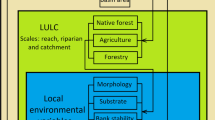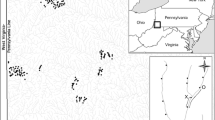Abstract
Biological and physical processes operate collaboratively through spatial or temporal scales to form ecological patterns, which are considered as a key element for understanding the natural liens within an ecosystem. Given the importance of scaling in ecological inference, this study elucidates how physical and biological variables under or within scales interact with each other. Density of Sicyopterus japonicus and environmental variables are examined and quantified at 70 stream sections distributed among 14 reaches in the Datuan stream catchment of northern Taiwan during the fall and winter of 2007, as well as the spring and summer of 2008. Hierarchical linear regression analysis indicates that S. japonicus density and habitat features are related on two levels, i.e., sections within reaches and reaches within streams throughout the year. Moreover, parameter uncertainty is represented by the confidence interval, which is calculated by the variance–covariance matrix of hierarchical linear model (HLM) parameters. According to HLM results, environmental variables at the section level (water depth and current velocity) and the reach level (stream width, water temperature, stream slope, soil erosion index) influence S. japonicus density. Although S. japonicus density varies significantly among reaches and sections within reaches, cross-level interaction may not always influence the distribution, processes and activities of S. japonicus throughout the year. The HLMs of S. japonicus density associated with stream features describe thoroughly multiple processes and the activities of S. japonicus across scales and within scales during different seasons. The annual HLM results represent the overall biological and physical patterns of the Datuan stream annually, explaining why they do not reflect seasonal associations or explain S. japonicus-related activities and environmental features of the stream.
Similar content being viewed by others
References
Abe, S., Iguchi, K., Ito, S., Uchida, Y., Ohnishi, H., & Ohmori, K. (2003). Habitat use of the grazing goby (Sicyopterus japonicus) in response to spatial heterogeneity in riparian shade. Journal of Freshwater Ecology, 18, 161–167.
Abe, S., Yodo, T., Matsubara, N., & Iguchi, K. (2007). Distribution of two sympatric amphidromous grazing fish Plecoglossus alivelis Temminck and Schlegel and Sicypoterus japonicus (Tanka) along the course of a temperate river. Hydrobiologia, 575, 415–422.
Akihito, K., Sakamoto, K., Ikeda, Y., & Iwata, A. (2000). Gobioidei. In: T. Nakabo (Ed.), Fishes of Japan with pictorial keys to the species (2nd edn.). Tokyo: Tokai University Press.
Barbour, M. T., Gerritsen, J., Snyder, B. D., & Stribling, J. B. (1999). Rapid Bioassessment Protocols for Use in Streams and Wadeable Rivers: Periphyton, Benthic Macroinvertebrates and Fish, Second Edition. EPA 841-B-99-002. USEPA.
Berk, R., & de Leeuw, J. (2006). Multilevel statistical models and ecological scaling. In: J. Wu, et al. (Eds.), Scaling and uncertainty analysis in ecology (pp. 67–88). Springer.
Bryk, A., & Raudenbush, S. W. (1992). Hierarchical linear models for social and behavioral research: Applications and data analysis methods. Newbury Park, CA, USA: Sage Publications.
Cohen, P., Andriamahefa, H., & Wasson, J. G. (1998). Towards a regionalization of aquatic habitat: Distribution of mesohabitat at the scale of a large basin. Regulated Rivers: Research, Management, 14, 391–404.
Cote, D. (2007). Measurements of salmonid population performance in relation to habitat in eastern Newfoundland streams. Journal of Fish Biology, 70, 1134–1147.
Coulombe-Pontbriand, M., & Lapointe, M. (2004). Geomorphic controls, riffle substrate quality, and spawning site selection in two semi-alluvial salmon rivers in the Gaspé Peninsula, Canada. River Research and Applications, 20, 577–590.
Cushing, D. H. (1975). Manne ecology and fisheries. New York: Cambridge Univ. Press.
Craven, S. W., Peterson, J. T., Freeman, M. C., Kwak, T. J., & Irwin, E. (2010). Modeling the relations between flow regime components, species traits, and spawning success of fishes in warmwater streams. Environmental Management, 46, 181–194.
Dêschenes, J., & Rodriguez, M. A. (2007). Hierarchical analysis of relationships between brook trout (Salvelinus fontinlais) density and stream habitat features. Canadian Journal of Fisheries and Aquatic Sciences, 64, 777–785.
Dunham, J. B., & Rieman, B. E. (1999). Metapopulation structure of bull trout: Influences of physical, biotic, and geometrical landscape characteristics. Ecological Applications, 9, 642–655.
Dunham, J. B., & Vinyard, G. L. (1997). Incorporating stream level variability into analyses of site level fish habitat relationships: Some cautionary examples. Transactions of the American Fisheries Society, 126, 323–329.
Durance, I., Celine, L., & Ormercod, S. J. (2006). Recognizing the importance of scale in the ecology and management of riverine fish. River Research and Applications, 22, 1143–1152.
Fausch, K. D., Torgersen, C. E., Baxter, C., & Hiram, W. L. (2002). Landscapes to riverscapes: Bridging the gap between research and conservation of stream fishes. BioScience, 52, 483–498.
Frimpong, E., Sutton, T. M., Engel, B. A., & Simon, T. P. (2005). Spatial-scale effects on relative importance of physical habitat predictors of stream health. Environmental Management, 36, 899–917.
Frissell, C. A., Liss, W. J., Warren, C. E., & Hurley, M. D. (1986). A hierarchical framework for stream habitat classification: Viewing streams in a watershed context. Environmental Management, 10, 199–214.
Ganio, L. M., Torgersen, C. E., & Gresswell, R. E. (2005). A geostatistical approach for describing spatial pattern in stream networks. Frontiers in Ecology and the Environment, 3, 138–144.
Goldstein, H. (2003). Multilevel statistical models. Oxford Univ. Press.
Hox, J. J. (2002). Multilevel analysis: Techniques and applications. Mahwah, NJ: Erlbaum.
Ibarra, A. A., Park, Y. S., Brosse, S., Reyjol, Y., Lim, P., & Lek, S. (2005). Nested patterns of spatial diversity revealed for fish assemblages in a west European river. Ecology of Freshwater Fish, 14, 233–242.
Iida, M., Watanabe, S., Shinoda, A., & Tsukamoto, K. (2008). Recruitment of amphidromous goby Sicypoterus japonicus to the estuary of the Ota River, Wakayama, Japan. Environmental Biology of Fishes, 83, 331–341.
Inoue, M., & Miyayoshi, M. (2006). Fish foraging effects on benthic assemblages along a warm-temperate stream: Differences among drift feeders, benthic predators and grazers. Oikos, 114, 95–107.
Inoue, M., & Nunokawa, M. (2002). Effects of longitudinal variations in stream habitat structure on fish abundance: An analysis based on subunit-scale habitat classification. Freshwater Biology, 47, 1594– 1607.
Isaak, D. J., & Hubert, W. A. (2000). Are trout populations affected by reach-scale stream slope. Canadian Journal of Fisheries and Aquatic Sciences, 57, 468–477.
Knapp, R. A., Vredenburg, V. T., & Matthews, K. R. (1998). Effects of stream channel morphology on golden trout spawning habitat and recruitment. Ecological Applications, 8, 1104–1117.
Kozel, S. J., Huber, W. A., & Parsons, M. G. (1989). Habitat features and trout abundance relative to stream gradient in some Wyoming streams. Northwest Science, 63, 555–582.
Liang, S. H. (2005). Developing models for freshwater bio-monitoring. Taipei: National Park Workshop.
Lin, Y.-P., Wang, C.-L., Yu, H.-H. & Wang, Y.-C. (2010a). Estimating and classifying spatial and temporal distributions of flow conditions for fish habitats by using geostatistical approaches with measured flow and fish data. Lecture Notes in Computer Science, 6016, 224–237.
Lin, Y.-P., Wang, C.-L., Yu, H.-H., & Wang, Y.-C. (2010b). Estimating and classifying spatial and temporal distributions of flow conditions for fish habitats by using geostatistical approaches with measured flow and fish data. Lecture Notes in Computer Science, 6016/2010, 224–237.
MacNeil, M. A., Graham, N. A. J., Polunin, N. V. C., Kulbicki, M., Galzin, R., Harmelin-Vivien, M., et al. (2009). Hierarchical drivers of reef-fish metacommunity structure. Ecology, 90, 252–264.
Magalhães, M. F., Batalha, D. C., & Collares-Pereira, M. J. (2002). Gradients in stream assemblages across a Mediterranean landscape: Contributions of environmental factors and spatial structure. Freshwater Biology, 47, 1015–1031.
McDowall, R. M. (1988). Diadromy in fishes. Migrations between freshwater and marine environments. London: Croom Helm.
McMahon, S. M., & Diez, J. M. (2007). Scales of association: Using hierarchical linear models to measure ecological systems. Ecology Letters, 10, 437–452.
Mesquita, N., Coelho, M., & Filomena, M. (2006). Spatial variation in fish assemblages across small Mediterranean drainages: Effects of habitat and landscape context. Environmental Biology of Fishes, 77, 105–120.
Poizat, G., & Pont, D. (1996). Multi-scale approach to species–habitat relationships: Juvenile fish in a large river section. Freshwater Biology, 36, 611–622.
Rabeni, C. F. (2000). Evaluating physical habitat integrity in relation to the biological potential of streams. Hydrobiologia, 422/423, 245–256.
Rabeni, C. F., & Sowa, S. P. (1996). Integrating biological realism into habitat restoration and conservation strategies for small streams. Canadian Journal of Fisheries and Aquatic Sciences, 53, 252–259.
Radtke, R. L., Kinzie, R. A., & Shafer, D. J. (2001). Temporal and spatial variation in length of larval life and size at settlement of the Hawaiian amphidromous goby Lentipes concolor. Journal of Fish Biology, 59, 928–938.
Raudenbush, S. W., & Bryk, A. S. (2002). Hierarchical linear models: Applications and data analysis (2nd edn.). Thousand Oaks, CA: Sage.
Raudenbush, S. W., Bryk, A. S., Cheong, Y. F., & Congdon, R. T. (2004). HLM: Hierarchical and Nonlinear Modeling (Version 6.06) [computer software], 6.0 6edition. Lincolnwood, IL: Scientific Software International.
Rosenfeld, J., Porter, M., & Parkinson, E. (2000). Habitat factors affecting the abundance and distribution of juvenile cutthroat (Oncorhynchus clarki) and coho salmon (Oncorhynchus kisutch). Canadian Journal of Fisheries and Aquatic Sciences, 57, 766–774.
Schneider, D. C. (2001). The rise of the concept of scale in ecology. Bioscience, 51, 545–553.
Shen, K. N., & Tzeng, W. N. (2002). Formation of a metamorphosis check in otoliths of the amphidromous goby Sicyopterus japonicus. Marine Ecology-Progress Series, 228, 205–211.
Shen, K. N., Lee, Y. C., & Tzeng, W. N. (1998). Use of otolith microchemistry to investigate the life history pattern of gobies in a Taiwanese stream. Zoological Studies, 37, 322–329.
Shiao, J. C. (1998). Early life history and fry resources of amphidromous gobies in Hsuikuluan River. Master Thesis, National Tsing Hua University, Hsinchu, Taiwan (in Chinese with English abstract).
Smiley, P. C., & Dibble, E. D. (2005). Implications of a hierarchical relationship among channel form, instream habitat, and stream communities for restoration of channelized streams. Hydrobiologia, 548, 279–292.
Storch, D., Evans, K. L., & Gaston, K. J. (2005). The species–area–energy relationship. Ecology Letters, 8, 487–492.
Thogmartin, W. E., Knutson, M. G., & Sauer, J. R. (2006). Predicting regional abundance of rare grassland birds with a hierarchical spatial count model. Condor, 108, 25–46.
Tzeng, C. S. (1986). The freshwater fishes of Taiwan. Taiwan: Ministry of Education (p. 183). (in Chinese).
Van de Pol, M., & Verhulst, S. (2006). Age-dependent traits: A new statistical model to separate within- and between-individual effects. American Naturalist, 167, 766–773.
Vázquez, D. P., & Simberloff, D. (2004). Indirect effects of an introduced ungulate on pollination and reproduction. Ecological Monographs, 74, 281–308.
Watson, G., & Hillman, T. W. (1997). Factors affecting the distribution and abundance of bull trout: An investigation at hierarchical scales. North American Journal of Fisheries Management, 17, 237–252.
Author information
Authors and Affiliations
Corresponding author
Rights and permissions
About this article
Cite this article
Yu, HH., Lin, YP. & Wang, CL. Monitoring and estimating scale-dependent hierarchical relationships between Sicyopterus japonicus density and stream habitat features in different seasons in northern Taiwan. Environ Monit Assess 182, 171–186 (2011). https://doi.org/10.1007/s10661-010-1867-8
Received:
Accepted:
Published:
Issue Date:
DOI: https://doi.org/10.1007/s10661-010-1867-8




